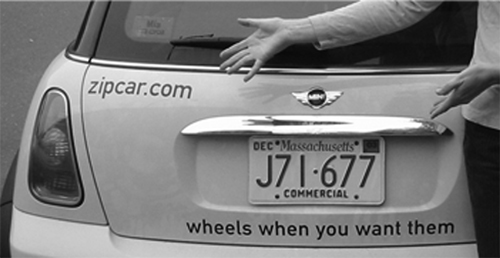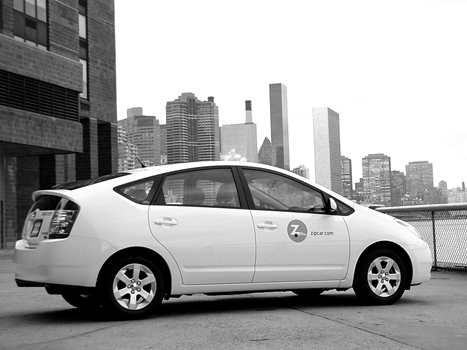How They Started (8 page)
Authors: David Lester

They started by leaving car keys hidden in glove boxes, out of view of potential thieves. With so few cars on the street, several times drivers had walked away with the key. Retrieving these keys took time and prevented the vehicle from being rented in the meanwhile. So Zipcar switched to leaving keys tethered to the steering column, in full view of potential car thieves. But with so few cars on the street, it was a risk they were willing to take. Thankfully, no vehicles were stolen before the new technology was ready that would prevent vehicle access by anyone other than the reserving member.

Robin presents Zipcar in action.
Robin and Antje expected word of mouth to be their primary marketing method, but knew they’d need to do some work to generate media coverage and spread the word further. Robin chose an “urban hip” look for Zipcar with a simple green logo. Members were also issued bumper stickers with slogans such as “My other car is a Zipcar” to put on their own cars.
The mainstay of Zipcar’s marketing campaign was a simple postcard that cost just 7 cents apiece. Clear plexiglass mailboxes were installed at Zipcar’s parking spots with postcards customers could take, and the two women and hourly helpers handed them out everywhere, at community meetings about environmental issues and at subway stops.
Antje got a midnight call from a member whose reserved Zipcar had a dead battery. So Antje bundled her infant son into a car seat, drove across town, and gave the member a jump start.
In a canny marketing move, the first few Zipcars were all green Volkswagen Beetles, a fit with the urban-hip positioning. The distinctive cars had just been redesigned and reintroduced by VW. This meant the cars were visibly different from traditional rental cars, immediately signaling that Zipcar was something new. The marketing strategy worked, and customers began signing up. As they used the service and liked it, they told others, and membership started to grow.
Through 2000, the women juggled their home responsibilities with the demands of Zipcar’s members. One rainy night just a few months after giving birth, Antje got a midnight call from a member whose reserved Zipcar had a dead battery. So Antje bundled her infant son into a car seat, drove across town, and gave the member a jump start.
“As a founder, you really do everything,” Antje says. “It’s an emotional rollercoaster. It would probably kill you if you did it your whole life, but the initial stages are exciting.”
The first year was a rocket ride, with the company expanding to 35 cars and 700 members in just over six months of operation, growing as much as 20 percent a month. By the end of the first year of operations, says Robin, the Boston market was operating at breakeven.
When Antje returned from maternity leave as 2000 drew to a close, it became apparent to Antje that Robin wanted to helm the company solo. With Robin’s business experience, she had the expertise to run the company, whereas Antje didn’t. The two had agreed at the outset to a 50-50 division of equity and Antje couldn’t force Robin out. Antje left Zipcar in January of 2001.
With Boston taking to Zipcar, Robin turned her attention to the first expansion market, Washington, DC. It turned out to be a tough market to crack. Timing was bad: the launch came two weeks before the 9/11 attacks, which sent the capitol into a media maelstrom and a psychological depression. Three months later, rival Flexcar entered the market, making DC the first US city with competing car sharing companies.
Worse, Flexcar won key car sharing parking spots in an open-bid contract with the Washington Metropolitan Area Transit Authority. Robin recalls it as “the first bad thing that ever happened” to Zipcar. While DC had ample parking and Zipcar easily found spaces, the Washington Metro also gave Flexcar valuable free marketing on the subway in addition to the parking spaces. The two competitors would duke it out in DC and other markets for years.
Robin continued to run Zipcar as it expanded into its third market, New York, in early 2002 and began to pilot relationships with universities in towns outside major cities. In September, after having spent grueling months setting up a $7 million funding round, Robin saw the deal fall apart at the final hour. She spent that fall regrouping in order to successfully raise $4 million. By the end of it, Robin was “100 percent wrecked. I didn’t have an ounce of energy left.” The board wanted fresh blood, and named former Boeing executive Scott Griffith the company’s new CEO.
When she departed in February 2003, Robin recalls, the company’s run rate was $2.5 million, and it had grown into the largest car sharing company in North America. Under Griffith’s leadership, Zipcar would continue its rapid expansion, forgoing profits in order to reinvest in the business to reach more markets ahead of its competitors. Sales shot from nearly $31 million in 2006 to more than $186 million in 2010.
“The interesting thing to me is that Zipcar is an idea someone else had,” Robin says, reflecting on the company’s success. “We just executed it better. My goal was to be the dominant nationwide and global player and to transform transportation and urban life. In fact, we did.”

A Zipcar car pictured against the NYC skyline.
Where are they now?
In 2007, Zipcar acquired archrival Flexcar for an undisclosed sum.
Today, Zipcar is the car sharing industry leader. The company went public in April 2011 in a $200 million IPO, of which Zipcar netted $117 million. By early 2012, it operated more than 9,000 cars and had over 650,000 members. The company has programs that help large corporations and governments meet energy reduction goals by using Zipcar. In all, the company raised over $61 million in private funding prior to its IPO.
The company continues to be unprofitable on a full-year basis, though it had a profitable third quarter in 2011. In 2010 Zipcar acquired London car sharing firm Streetcar Limited and in 2011 exercised rights to buy Spain’s Avancar.
After leaving Zipcar at the end of 2000, Antje became a principal in the environmental consulting business Ecochange. She is the administrative director of Tufts Institute of the Environment (TIE). She also serves on the sustainability advisory board of GreenerU, a Massachusetts company that helps college campuses use less energy.
Since leaving Zipcar, Robin has founded two other companies (GoLoco and Buzzcar) and serves on several advisory boards for the US government, the International Transport Forum and the World Resources Institute.

Buying power
Founder:
Pierre Omidyar
Age of founder:
28
Background:
Software engineer
Founded in:
1995
Headquarters:
San Jose, California
Business type:
Online auction site

Fifteen dollars might seem an insignificant amount,
but it was the sum of money that sparked the business known today as eBay, the global auction site with $11.7 billion in revenue.
Founder Pierre Omidyar, a software engineer, was experimenting with online auctions as a hobby and advertised a broken laser pointer for sale. He was amazed that someone would consider paying just under $15 ($14.83 to be precise) for an item that didn’t work, and it convinced him that there was potential in a business that catered to people’s passion for collecting.
The laser pointer was duly sold and shipped and has gone down in history as eBay’s first transaction. Today eBay is the world’s largest online marketplace and one of the most successful companies of the dot-com era—and is still making headlines around the world.
Born in Paris, Pierre moved with his family to Washington, DC, in 1973 when he was six years old, and he was fascinated by computers and technology from an early age. While other kids were out playing sports, he was more likely to be found indoors tinkering with hardware and learning how to program computers. He taught himself to program in BASIC and used his technology skills to get his first job, computerizing his school library’s card catalog for $6 an hour.
Unsurprisingly, Pierre later decided to major in computer science at Tufts University, where he nurtured a passion for Apple software. It was an early sign of his entrepreneurial flair and desire to do something different. At the time, Apple was seen as a trendy, non-traditional technology company, a minnow challenging established giants such as IBM. With a beard, sunglasses and his long hair tied back in a ponytail, Pierre sported a look that was well suited to his love of Apple.
In the late 1980s and early 1990s, he worked as a Macintosh programmer, securing a number of jobs at software companies in Silicon Valley before deciding to venture out on his own. Together with friends he founded Ink Development Corporation, which aimed to produce software for pen-based computers, forerunners of the Palm Pilot. This part of the business, however, did not take off as rapidly as he had hoped, and a year later Pierre decided to focus on another offshoot of the business—online commerce. The company was subsequently renamed eShop, and it operated as an electronic retailing company. While the concept of the Internet was gathering momentum around the world, the pace of technology was still too slow for Pierre’s liking, and he quit eShop in 1994 in order to pursue a business that would propel him one step closer to the Internet. Pierre retained a stake in eShop, however, and in hindsight this proved to be a wise move. Barely two years later, eShop caught the attention of software giant Microsoft, which acquired the company and made Pierre a millionaire before his 30th birthday.
By this point, Pierre had caught the Internet bug. Luckily, he was in the right place at the right time, as a host of other online businesses were now starting to emerge. Pierre cultivated his interest in the Internet by joining mobile communications startup General Magic. It was during his time here that the idea for AuctionWeb, which would eventually become eBay, took shape. Like many great business ideas, Pierre’s creation stemmed from a bad personal experience. A few years prior, he had placed an order online for shares in a company that looked promising, but he soon discovered that the stock had soared by 50 percent before his order had been fulfilled.